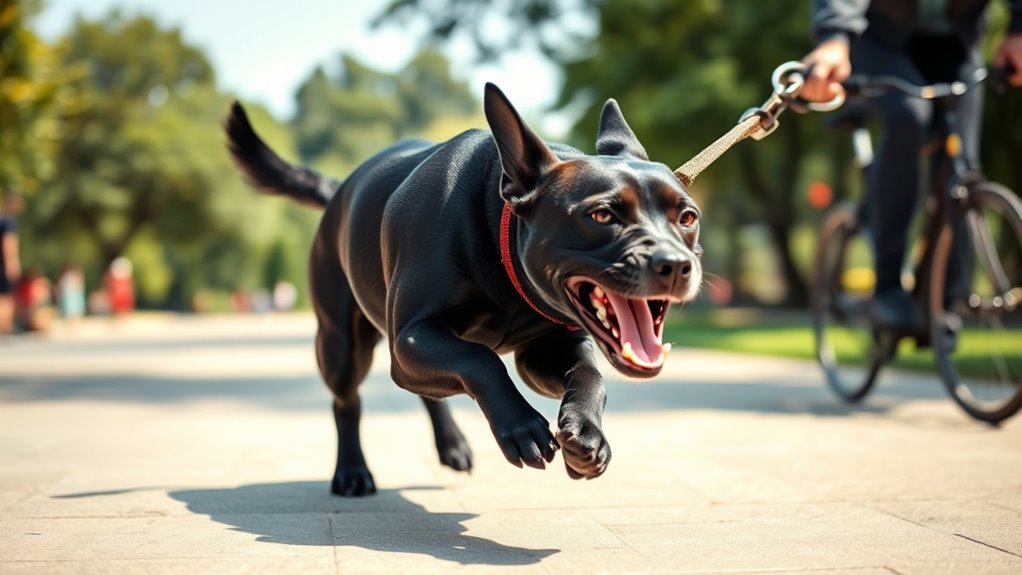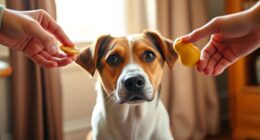Leash reactivity involves your dog lunging, barking, or pulling when they see other dogs, often out of fear, excitement, or communication. To manage this, pay close attention to their body language and avoid punishment. Instead, reward calm behavior and redirect their focus with known commands like “sit” or “look.” Being consistent and patient helps your dog feel more confident around distractions. Keep exploring ways to better understand and control this behavior as you continue working together.
Key Takeaways
- Leash reactivity manifests as lunging, barking, or pulling, often due to fear, excitement, or perceived threat from other dogs.
- Recognizing body language helps in identifying triggers and managing your dog’s reactions effectively.
- Positive reinforcement, such as treats and praise, encourages calm behavior around other dogs.
- Gradually increasing distance and using commands like “look” or “sit” can redirect attention and reduce reactivity.
- Consistent patience and training, avoiding punishment, are essential for long-term behavioral improvement.

Have you ever wondered why your dog suddenly pulls, barks, or lunges when passing other dogs on a walk? This behavior, known as leash reactivity, can be frustrating and confusing, but understanding what’s happening can help you address it effectively. When your dog reacts this way, they’re often communicating with their body language—tensing up, hackles raised, ears back, or stiff posture—all signs that they feel threatened, excited, or anxious. Recognizing these signals is key to managing their behavior. Instead of punishing your dog for reacting, focus on using positive reinforcement to encourage calmness. For instance, when your dog notices another dog but remains relaxed, praise them calmly and reward their good behavior with treats or affection. Over time, this helps your dog associate seeing other dogs with positive experiences rather than fear or aggression.
Managing leash reactivity requires patience and consistency. When your dog begins to react, avoid pulling on the leash or yelling, as these actions can escalate their anxiety or frustration. Instead, redirect their attention with a command they know well, like “look” or “sit,” and reward them when they comply. This shifts their focus from the other dog to you, reinforcing calm behavior. It’s important to start practicing in controlled environments, gradually increasing the level of distraction as your dog learns to stay composed. Always keep a safe distance from other dogs during training sessions, so your dog doesn’t feel overwhelmed. Over time, as they become more confident and relaxed, you can decrease the distance, but never push them into discomfort. Additionally, engaging in puppy socialization can help your dog develop better coping skills around other dogs, reducing reactive tendencies.
Consistency is essential. Every walk is an opportunity for training and reinforcement. Be patient and avoid punishing your dog for their initial reaction—this can make the problem worse. Instead, stay calm and use positive reinforcement to reward calmness and self-control. Remember, leash reactivity doesn’t develop overnight, and progress can be slow. Celebrate small victories, like your dog remaining calm as another dog passes by, and keep practicing regularly. With time, patience, and positive reinforcement, you can help your dog feel more confident and secure in new situations. Ultimately, understanding your dog’s body language and responding with kindness and patience will strengthen your bond and reduce reactive behaviors, making walks more enjoyable for both of you.
Frequently Asked Questions
Can Leash Reactivity Develop Suddenly Without Warning?
Leash reactivity can sometimes develop suddenly without clear warning signs, but often, early warning signs like increased tension or barking are present. You might notice your dog becoming more anxious or reactive in certain situations, which could lead to a sudden onset of lunging or barking. Staying attentive to these subtle cues helps you intervene early, preventing escalation. Remember, reactivity can escalate quickly, so consistent training and observation are essential.
Is Leash Reactivity Common in Puppies or Just Adult Dogs?
It’s a bit like discovering a secret stash—leash reactivity can show up in puppies, not just adult dogs. While some breed tendencies make certain pups more prone to it, early puppy behavior often includes curiosity and frustration, leading to reactivity. You might see lunging or barking as they explore their environment. Addressing it early helps prevent it from becoming a bigger issue later, turning your pup’s energy into positive training.
How Long Does It Typically Take to See Progress?
Progress timeline varies, but with patience and consistency, you might start seeing improvements in a few weeks. Some dogs respond quickly, while others may take several months. Stay committed to your training routine, and avoid rushing results. Remember, every dog is unique, so be patient and consistent. By doing so, you’ll build confidence and reduce reactivity, leading to better walks and a calmer, happier pup over time.
Are Certain Breeds More Prone to Leash Reactivity?
You might notice that herding breeds like Border Collies and Aussies are more prone to leash reactivity because of their breed tendencies and genetic predispositions for high energy and alertness. Studies show certain breeds are more reactive, making training more challenging. Knowing this, you can tailor your approach, focusing on calm, consistent training to manage your dog’s reactivity effectively, regardless of breed.
Can Leash Reactivity Be Completely Cured or Only Managed?
Leash reactivity can often be managed effectively through behavior modification and prevention strategies, but it’s rarely completely cured. You’ll need consistent training, patience, and positive reinforcement to help your dog feel more secure and less reactive. Preventing triggers and gradually exposing your dog to stimuli at manageable levels can reduce reactivity over time. While some dogs improve markedly, ongoing management might be necessary to maintain progress.
Conclusion
Many believe leash reactivity is just bad manners, but research suggests it’s often a mix of fear and frustration. By understanding these triggers, you can better manage your dog’s behavior and reduce stress for both of you. So, next time your pup lunges or barks, remember it’s not just misbehavior—there’s usually an underlying reason. With patience and proper training, you can turn those reactive moments into calm, controlled walks.










